Lansfordite is a hydrated magnesium carbonate mineral with composition: MgCO3·5H2O. Landsfordite was discovered in 1888 in a coal mine in Lansford, Pennsylvania. It crystallizes in the monoclinic system (space group P21/c) and typically occurs as colorless to white prismatic crystals and stalactitic masses. It is a soft mineral, Mohs hardness of 2.5, with a low specific gravity of 1.7. It is transparent to translucent with refractive indices of 1.46 to 1.51. The mineral will effloresce at room temperature, producing nesquehonite.
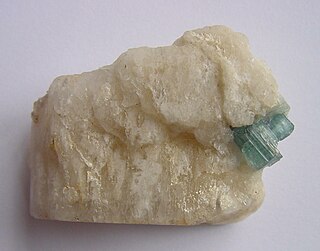
Beryllonite is a rare sodium beryllium phosphate mineral with formula NaBePO4. The tabular to prismatic monoclinic crystals vary from colorless to white or pale yellowish, and are transparent with a vitreous luster. Twinning is common and occurs in several forms. It exhibits perfect cleavage in one direction. The hardness is 5.5 to 6 and the specific gravity is 2.8. Refractive indices are nα = 1.552, nβ = 1.558 and nγ = 1.561. A few crystals have been cut and faceted, but, as the refractive index is no higher than that of quartz, they do not make very brilliant gemstones.

Mesolite is a tectosilicate mineral with formula Na2Ca2(Al2Si3O10)3·8H2O. It is a member of the zeolite group and is closely related to natrolite which it also resembles in appearance.
Zircophyllite is a complex mineral, formula (K,Na)3(Mn,Fe)2+7(Zr,Ti,Nb)2Si8O24(OH,F)7. It crystallizes in the triclinic - pinacoidal crystal class as dark brown to black micaceous plates. It has perfect 001 cleavage, a Mohs hardness of 4 to 4.5 and a specific gravity of 3.34. Its indices of refraction are nα=1.708 nβ=1.738 nγ=1.747 and it has a 2V optical angle of 62°.

Alarsite (AlAsO4) is an aluminium arsenate mineral with its name derived from its composition: aluminium and arsenate. It occurs as brittle subhedral grains which exhibit trigonal symmetry. It has a Mohs hardness of 5-5.5 and a specific gravity of 3.32. It is semitransparent, colorless with pale yellow tints and shows a vitreous luster. It is optically uniaxial (+) with refractive indices of nω = 1.596 and nε = 1.608.

Eosphorite is a brown (occasionally pink) manganese hydrous phosphate mineral with chemical formula: MnAl(PO4)(OH)2·H2O. It is used as a gemstone.

Santabarbaraite is an amorphous ferric hydroxy phosphate mineral hydrate that was discovered in Tuscany, Italy during 2000. It also can be found in Victoria, Australia and Lake Baikal, Siberia.
Panethite, chemical formula (Na,Ca)2(Mg,Fe)2(PO4)2, is a rare phosphate mineral that was only found in one meteorite on Earth. It was originally found in the Dayton meteorite in Ohio. It is classified as H-M symbol (2/m) with space group of P21/n. It is amber in color. It was named in the honor of Friedrich Adolf Paneth (1887–1958), a German chemist who made many contributions toward the discovery of the origin of the universe, and especially studies of meteorites.

Plancheite is a hydrated copper silicate mineral with the formula Cu8Si8O22(OH)4•(H2O). It is closely related to shattuckite in structure and appearance, and the two minerals are often confused.
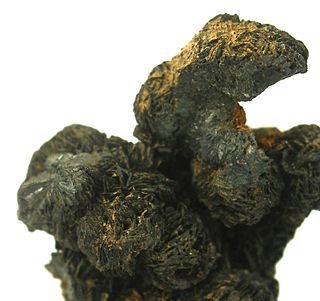
Hagendorfite is an iron phosphate mineral with the chemical formula of (Na,Ca)MnFe2(PO4)3 and is named after where the mineral was discovered, Hagendorf-Süd, Bavaria, Germany.
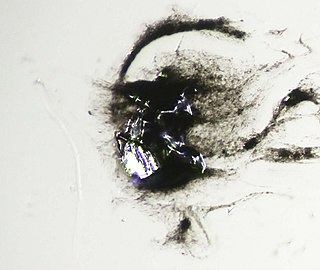
Gabrielite is a rare thallium sulfosalt mineral with a chemical formula of Tl6Ag3Cu6(As,Sb)9S21 or Tl2AgCu2As3S7.

Nambulite is a lithium bearing manganese silicate mineral with the chemical formula (Li,Na)Mn4Si5O14(OH). It is named after the mineralogist, Matsuo Nambu (born 1917) of Tohoko University, Japan, who is known for his research in manganese minerals. The mineral was first discovered in the Funakozawa Mine of northeastern Japan, a metasedimentary manganese ore.

Eveite is a manganese arsenate mineral in the olivenite group. Its chemical formula is Mn2AsO4OH. It is found only in Långban, Filipstad, Värmland, Sweden and at the Sterling Mine in New Jersey, United States. It is a dimorph of sarkinite and is isostructural with adamite. The name, for the biblical "Eve", comes from its structural similarities to adamite and is also a reference to its apple-green color. It can also be pale yellow. Eveite is an orthorhombic mineral, which means it has three crystallographic axes of unequal lengths which are at 90° to one another.
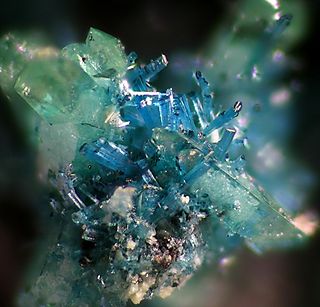
Keyite is a mineral with the chemical formula Cu2+3Zn4Cd2(AsO4)6 · 2H2O. The name comes from Charles Locke Key, an American mineral dealer who furnished its first specimens. Keyite is monoclinic-prismatic, meaning its crystal form has three unequal axes, two of which have 90° angles between them and one with an angle less than 90°. Keyite belongs to the biaxial optical class, meaning it has more than one axis of anisotropy, in which light travels with zero birefringence, and three indices of refraction, nα = 1.800, nβ, and nγ = 1.870. Being a very rare cadmium copper arsenate, keyite is only found in Tsumeb, Namibia in the Tsumeb mine, a world-famous copper mine known for its abundance of rare and unusual minerals.

Stellerite is a rare mineral discovered by and named after Georg Wilhelm Steller, a German explorer and zoologist. The mineral has a general formula of Ca[Al2Si7O18]·7H2O. Like most rare minerals, there are few commercial uses for stellerite. Mineral collectors are lucky to find it in good enough crystal form. Zeolites, including stellerite, have been studied using a dehydration process to gauge the potential use of their phases as molecular sieves, sorbents, and catalysts.
Ericssonite has a general formula of BaMn2FeO[Si2O7](OH). It was discovered in 1967 and named after John Ericsson (July 31, 1803 – March 8, 1889), a well known Swedish American inventor, engineer and designer of the iron-clad ship USS Monitor. Ericssonite was discovered in the Jakobsberg Mine in Värmland, Sweden.
Sweetite has a general formula of Zn(OH)2. The name is given after a curator of mineral department of The British Museum, Jessie May Sweet (1901–1979). It occurs in an oxidized vein in limestone bedrock with galena, ashoverite, wülfingite, anglesite, cerussite, hydrocerussite, litharge, fluorite, palygorskite and calcite.
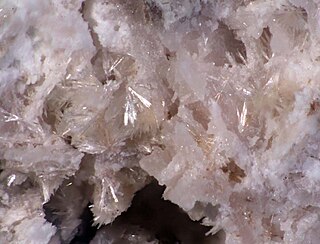
Laplandite has a general formula of Na4CeTiPO4Si7O18•5H2O, and is found primarily in igneous rocks. This silicate mineral has been found as inclusions in pegmatites, primarily in the Kola Peninsula in Lappland, where the mineral's name gets its origin. Laplandite is orthorhombic, which states that crystallographically, it contains three axes of unequal lengths that all intersect at 90 degrees, perpendicular to one another. The shape of the crystal is bipyramidal, and is similar in structure to olivine or aragonite. Because of these different axes lengths, it shows anisotropism, which will allow for the visibility of birefringence. This property can give the mineral very distinct colors when viewed under cross-polarization. Laplandite has three different indices of refraction, which are measures of the speed of light in vacuum divided by the speed of light within the mineral, determined individually on each axis. Due to these different indices, Laplandite is a biaxial mineral, which states that the mineral will have two optic axes. Under the microscope, this mineral has moderate relief, which describes the contrast between Laplandite's refractive index and the refractive index of the mounting medium on which it is placed. The relief can be seen physically as how easily you can see the boundary lines of the mineral under plane polarized light in a petrographic microscope.

Allanpringite is a phosphate mineral named after Australian mineralogist Allan Pring of the South Australian Museum. Allanpringite is a Fe3+ analogue Al-phosphate mineral wavellite, but it has a different crystal symmetry – monoclinic instead of orthorhombic in wavellite. It forms needle-like crystals, which are always twinned and form parallel bundles up to about 2 mm long. They are often found in association with other iron phosphates in abandoned iron mines.
Zigrasite is a phosphate mineral with the chemical formula of MgZr(PO4)2(H2O)4. Zigrasite was discovered and is only known to occur in the Dunton Quarry at Oxford County, Maine. Zigrasite was specifically found in the giant 1972 gem tourmaline-bearing pocket at the Dunton Quarry. Zigrasite is named after James Zigras who originally discovered and brought the mineral to attention.















